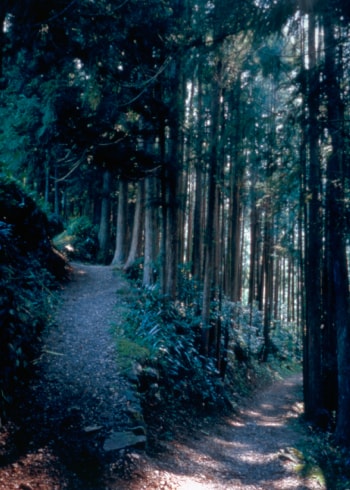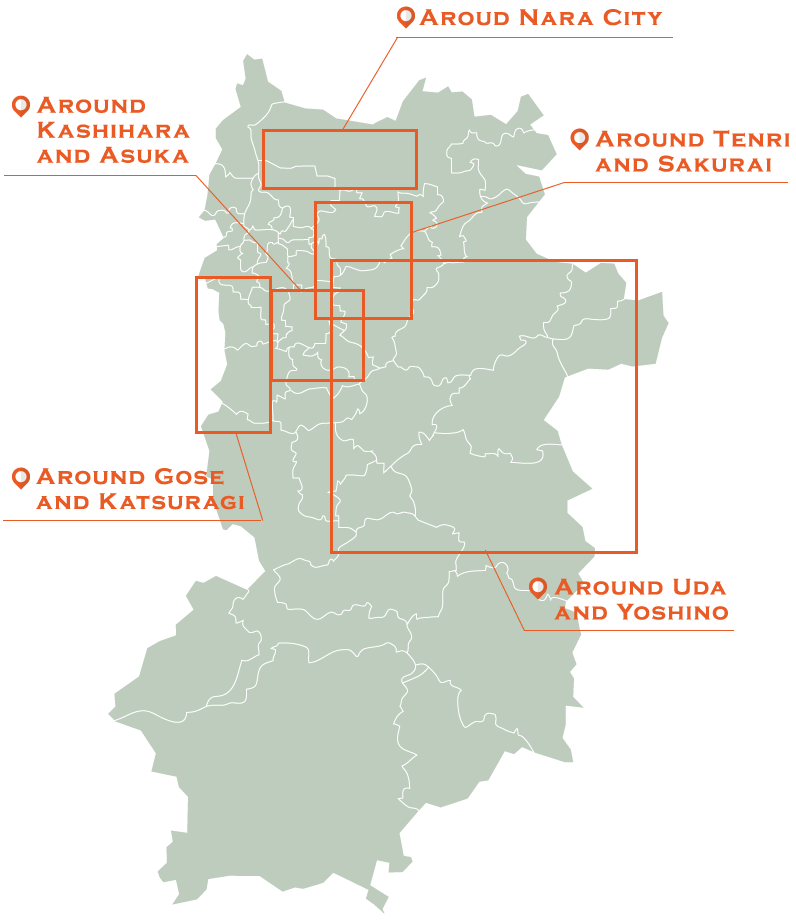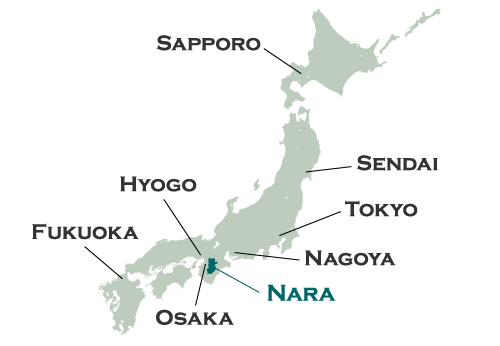



Searching for the proper place for his capital, Emperor Jimmu decided to head east.
On the way from Kumano (in present day Wakayama Prefecture) to Yamato (in present day Nara Prefecture), he received divine instructions from the Great Deity Takagi. The deity said, “Oh mighty child of the heavenly deities, do not proceed further in this direction. There are many unruly deities waiting for you. I will dispatch the Raven with Many Feet, so please follow his guidance.”
Indeed, the Raven with Many Feet appeared and led the Emperor to the lower reaches of the Yoshino River. There, a man was catching fish in a bamboo trap. The Emperor asked his name, and the man replied, “I am a deity of this land, and my name is Niemotsu-no-ko (He Who Has Fish).” This deity is said to be the ancestor of the Cormorant Fishermen of Ada.
The Emperor journeyed on and encountered a man with a tail who came out from a shining well. The Emperor asked his name, and the man said, “I am a deity of this land, and my name is Ihika (Shining Well).”
As the Emperor entered the mountains, he encountered a man with a tail who appeared pushing aside boulders and saying, “I am a deity of this land, and my name is Iwaoshi-waku-no-ko (He Who Appears by Pushing Away Rocks). I came to you as I heard that the mighty child of the heavenly deities was arriving.”
From there, after a difficult journey through the deep mountains, Emperor Jimmu finally reached Uda (in present day Nara), which he made the new capital.


In Uda, there lived two brothers, E-ukashi (the elder Ukashi) and Oto-ukashi (the younger Ukashi). The Emperor Jimmu sent the Raven with Many Feet as a messenger to them. The raven spoke to the brothers, “The mighty child of the heavenly deities is arriving. Are you willing to serve him?”
E-ukashi shot off a whistling arrow in an attempt to drive away the Raven with Many Feet. E-ukashi then planned to ambush the Emperor’s troops, but he failed to assemble the forces needed to mount a challenge.
E-ukashi then disingenuously pledged to serve Emperor Jimmu. He even built a castle for the Emperor Jimmu, but the castle actually was designed as a trap to kill him.
Oto-ukashi came forth and showed his loyalty to the Emperor by revealing his elder brother’s plot.
Learning of this, members of the Emperor’s retinue called upon E-ukashi to show the castle to them. “You have built this castle for Emperor Jimmu. Please enter first and show us what you have created.”
E-ukashi hesitated, but spears were raised and bows were drawn tight, all aimed at him. E-ukashi was forced inside, where he was caught and killed by his own trap. His body was then cut into pieces in the field outside the castle. Since then, the area has been known as Chihara (Bloody Field).
Emperor Jimmu kept heading east, pacifying many unruly deities and defeating enemies along the way.
After more than 16 years, he finally established Kashihara Palace in Unebi (in present day Nara). One day, he fell in love with one of seven girls that he saw playing in a field and married her. She was Isuke-yori-hime, daughter of the Great Deity O-mono-nushi.


Emperor Keiko became wary of the fearlessness of his own son, Prince Ousu. So the Emperor sent the Prince off to the West to conquer two brothers known as Kumaso Takeru (Brave of Kumaso).
Prince Ousu was just 15 or 16 years old, and he wore his long hair in a topknot. Worried for his safety, his aunt, Princess Yamato-hime, who was a priestess in the Ise Shrine, gave him her sacred robe. The robe gave him the protection of the Supreme Sun Deity Amaterasu.
Carrying her robe, Prince Ousu headed west. When he arrived at the house of the Kumaso Takeru brothers, he found that it was heavily guarded by warriors.
Prince Ousu disguised himself as a maiden by wearing his aunt’s robe and letting his long hair down. He snuck into a feast being held by the Kumaso Takeru brothers.
The elder Kumaso Takeru was mesmerized by the beauty of this maiden, and Prince Ousu easily killed him. Prince Ousu then chased after the younger Kumaso Takeru.
As Prince Ousu raised his sword, the younger Kumaso Takeru implored Prince Ousu to let him speak, “Wait. Before you kill me, I must say this. There are no mightier men than us in the west, but there is a man mightier than us from Yamato. Honoring your bravery, I will give you my name. From now on, may you be known as Prince Yamato Takeru.”
After that, Prince Ousu killed the younger Kumaso Takeru. From that day on, Prince Ousu became known as Yamato Takeru, the Brave of Yamato.


Prince Ousu assumed the name Yamato Takeru and headed back home. On his way, he conquered Izumo Takeru.
He returned to his father to report that his mission had been accomplished. Instead of commending his son, Emperor Keiko commanded Yamato Takeru to leave again right away to subdue and pacify the unruly deities and disobedient people in the East.
Brokenhearted, Prince Yamato Takeru visited his aunt, Princess Yamato-hime, and lamented, “Does the Emperor want me to die? Why did he send me to fight with the evil people in the West? Now that I have returned, why is he sending me out again so soon? He is not even giving me troops to subdue the evil people in the East. He must be hoping that I will die soon.”
On his departure, his aunt gave him the Sword of Kusanagi. She also handed him a bag saying, “If you ever find yourself in trouble, open this bag.”
With her words in mind, Yamato Takeru headed for the East, even before he had recovered from his hard trip to the West.


Defeating enemies and overcoming many obstacles, Prince Yamato Takeru conquered the East and started to head back home. He was helped by the Sword of Kusanagi and the fire-making stone in the bag that his aunt had given him.
When he reached the Province of Owari (in present day Aichi Prefecture), he married Lady Miyazu-hime. However, their peaceful life together did not last long.
When he went out to defeat the Deity of Mt. Ibuki, he encountered a huge white boar at the foot of the mountain. As he had left his mighty sword behind with his wife, he said to the boar, “You must be a messenger of the mountain deity. I will come back later to kill you.”
He rushed up the mountain. Suddenly, heavy sleet and hail started falling from the sky, beating down upon Yamato Takeru and leaving him in confusion. The boar he had encountered was the Deity of Mt. Ibuki in disguise.
Prince Yamato Takeru managed to come down from the mountain, but the storm had taken a heavy toll on him physically. He had to drag his body, but he was determined to get home.
When he reached Nobono (in present day Mie Prefecture), he was overcome by homesickness and sang this song:
Yamato is
The highest part of the land
The mountains are green partitions
Lying layer upon layer
Nestled among the mountains
How beautiful is Yamato
Prince Yamato Takeru became gravely ill, and he died seeing his home again only in his mind’s eye.
When the news of his death reached Yamato, many people mourned his death and created a mound to commemorate him.
The soul of Prince Yamato Takeru transformed into a white bird. After visiting a few places, the bird flew high into the sky and vanished.



Getting Around IN nara
Nara is about a 30-minute train ride from Kyoto or Osaka, and getting around in Nara is easy. Major tourist destinations are connected by Nara’s extensive public transportation system. Rental bicycles are also a popular way to find your way around.
Yoshino River

The panoramic views from the Ada Bridge are particularly well known for revealing the unspoiled beauty of the surrounding mountains and river valley. (Gose City)
Miyataki

This area is on the Yoshino River, near where Emperor Tenmu, who commissioned Kojiki, vacationed. In a Kojiki story, Emperor Jimmu encountered a Deity of the land, Niemotsu-no-ko catching fish around the Yoshino River. (Yoshino Town)
Adahime Jinja Shrine

A Deity of the land, Niemotsu-no-ko is known as the originator of fishing using birds in the Ada area. The main deity of the shrine, Adahime, is from Kyushu, the southern island of Japan. (Gose City)
Mausoleum of Emperor Jimmu

Emperor Jimmu was the first emperor of Japan. His tomb near Kashihara Jingu Shrine claims that the Emperor lived to be 137 years old. (Kashihara City)
Kashihara Jingu Shrine

Kojiki states that Emperor Jimmu governed the country from Kashihara Palace. Kashihara Jingu Shrine was built in the late 19th century on the palace’s original site. (Kashihara City)
Yatagarasu Jinja Shrine

The Deity Taketsunumi that transformed into “The Raven with Many Feet” is enshrined here. The statue of the raven within the grounds of the shrine is the mascot of Japan’s soccer team. (Uda City)
Isagawa Jinja Shrine

Empress Isuke-yori-hime, a wife of Emperor Jimmu, is enshrined in this place. The shrine is known for a Lily Festival it holds each year on June 17. (Nara City)
Mt. Torimi

This mountain has an elevation of 735 meters. There is a viewing tower at the top, which makes it a great spot for looking out over the mountains and landscape that Emperor Jimmu traveled through. (Uda City)
Sakurai City Center of Archeological Operations

Many interesting ancient artifacts excavated from archeological sites around Sakurai City are on display in the museum. (Sakurai City)
Shiratori-no-Misasagi
(Mausoleum of Prince Yamato Takeru)

This mound was built to commemorate Prince Yamato Takeru, who flew away as a white bird after briefly stopping here. It is a good place to look out over beautiful Mt. Katsuragi, which appears in many Kojiki stories. (Gose City)
Shibutani Mukaiyama Tumulus

This 300-meter-long mound is believed to be the tomb of Emperor Keiko, father of Prince Yamato Takeru. (Tenri City)
Song Monument

A song that Prince Yamato Takeru sang in Kojiki can be seen on a monument in front of Hibara Jinja Shrine. The engraving on the monument is based on calligraphy by the Nobel Prize-winning novelist Yasunari Kawabata. (Sakurai City)